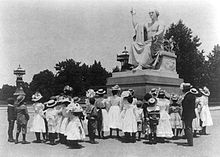George Washington (Greenough)
| George Washington | |
|---|---|
 | |
| Artist | Horatio Greenough |
| Year | 1840 |
| Type | Carrara marble |
| Dimensions | 3.5 m × 2.6 m (136 in × 102 in × 82 1/2[1] in) |
| Location | National Museum of American History, Washington, D.C., United States |
| 38°53′28″N 77°01′50″W / 38.89111°N 77.03056°W | |
| Owner | Smithsonian Institution |
George Washington, also known as Enthroned Washington, is a large
Horatio Greenough based Enthroned Washington on Phidias' Statue of Zeus at Olympia, one of the Seven Wonders of the Ancient World which was destroyed in Late Antiquity.[3]
Description
The seated and sandal wearing Washington gazes sternly ahead. He is bare-chested and his right arm and hand gesture with upraised index finger toward Heaven. His left palm and forearm cradle a sheathed sword, hilt forward, symbolizing Washington turning over power to the people at the conclusion of the American Revolutionary War. The representation of Washington in Roman clothing is indicative of Neoclassical art.
The original Latin inscription, on the back of the statue reads:
and translates as: "Horatio Greenough made this image as a great example of freedom, which will not survive without freedom itself."
History

On July 14, 1832, the U.S. Congress commissioned Greenough to create a statue of Washington for display in the
Because of the sculpture's weight and the dim light inside the rotunda, the statue was relocated to a pedestal on the east lawn of the Capitol in 1843. Disapproval continued and some joked that Washington was desperately reaching for his clothes,[5] then on exhibit at the Patent Office several blocks to the north.
The statue was brought back indoors to the
Popular culture references
The
The statue appears near the beginning of the 2013 first-person shooter, BioShock Infinite, set in an alternate 1912 where Washington, Benjamin Franklin, and Thomas Jefferson are worshiped by the inhabitants of the floating city of Columbia.
See also
- List of monuments dedicated to George Washington
- List of statues of George Washington
- List of sculptures of presidents of the United States
- The Apotheosis of Washington
- George Washington, statue by Antonio Canova
- George Washington's resignation as commander-in-chief
References
- ^ "George Washington by Horatio Greenough / American Art". si.edu. Archived from the original on 2013-10-19. Retrieved 2013-10-18.
- ^ a b c "George Washington, (sculpture)". Inventories of American Painting and Sculpture, Smithsonian American Art Museum. Archived from the original on September 24, 2012. Retrieved August 2, 2011.
- S2CID 159821356.
- ^ "George Washington by Horatio Greenough, 1840". National Museum of American History. 20 April 2017. Archived from the original on 2019-02-16. Retrieved 2019-02-16.
- ^ "Smithsonian Press-Legacies-2Shrine to the Famous-George Washington, sculpture by Horatio Greenough, 1840". Smithsonianlegacies.si.edu. Archived from the original on 2002-11-11. Retrieved 2013-09-16.
